
As of September 2024, Vietnam maintains diplomatic relationships with 191 UN member states, State of Palestine and Sahrawi Arab Democratic Republic.

The Cambodian Civil War was a civil war in Cambodia fought between the Communist Party of Kampuchea against the government of the Kingdom of Cambodia and, after October 1970, the Khmer Republic, which had succeeded the kingdom after a coup. The conflict was part of the Second Indochina War (1955–1975).

The Cambodian–Vietnamese War was an armed conflict between Democratic Kampuchea, controlled by Pol Pot's Khmer Rouge, and the Socialist Republic of Vietnam. The war began with repeated attacks by the Kampuchea Revolutionary Army on the southwestern border of Vietnam, particularly the Ba Chúc massacre which resulted in the deaths of over 3,000 Vietnamese civilians. On 23 December 1978, 10 out of 19 of the Khmer Rouge's military divisions opened fire along the border with Vietnam with the goal of invading the Vietnamese provinces of Đồng Tháp, An Giang and Kiên Giang. On 25 December 1978, Vietnam launched a full-scale invasion of Kampuchea, occupying the country in two weeks and removing the government of the Communist Party of Kampuchea from power. In doing so, Vietnam put an ultimate stop to the Cambodian genocide, which had most likely killed between 1.2 million and 2.8 million people—or between 13 and 30 percent of the country's population. On 7 January 1979, the Vietnamese captured Phnom Penh, which forced Pol Pot and the Khmer Rouge to retreat back into the jungle near the border with Thailand.
The Khmer Krom are ethnically Khmer people living in or from the Mekong Delta, the south western part of Vietnam known in Khmer as Kampuchea Krom. The Khmer Krom people are considered an the indigenous people of parts of Southern Vietnam and have the oldest extant recorded history of inhabiting in the region. In Vietnam, they are recognized as one of Vietnam's fifty-three ethnic minorities.
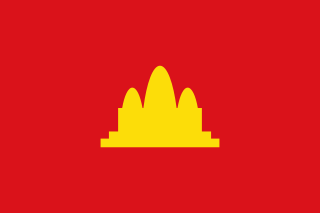
The Coalition Government of Democratic Kampuchea, renamed in 1990 to the National Government of Cambodia, was a coalition government in exile composed of three Cambodian political factions, namely Prince Norodom Sihanouk's FUNCINPEC party, the Party of Democratic Kampuchea and the Khmer People's National Liberation Front (KPNLF) formed in 1982, broadening the de facto deposed Democratic Kampuchea regime. For most of its existence, it was the internationally recognized government of Cambodia.

The People's Republic of Kampuchea (PRK) was a partially recognised state in Southeast Asia which existed from 1979 to 1989. It was a satellite state of Vietnam, founded in Cambodia by the Vietnamese-backed Kampuchean United Front for National Salvation, a group of Cambodian communists who were dissatisfied with the Khmer Rouge due to its oppressive rule and defected from it after the overthrow of Democratic Kampuchea, Pol Pot's government. Brought about by an invasion from Vietnam, which routed the Khmer Rouge armies, it had Vietnam and the Soviet Union as its main allies.
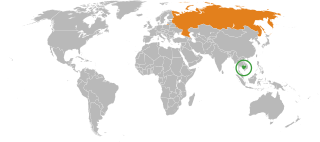
Cambodia–Russia relations are the bilateral relations of Cambodia and Russia. The relations between both countries were strong since the Soviet era. Russia has an embassy in Phnom Penh. Cambodia has an embassy in Moscow. Both countries are full members of the East Asia Summit.

Russia–Singapore relations are the bilateral foreign relations between the two countries, Russia and Singapore. Russia has an embassy in Singapore. Singapore has an embassy in Moscow. Both countries are full members of APEC. Due to the 2022 Russian invasion of Ukraine, relations became very tense after Singapore imposed sanctions against Russia. Russia placed Singapore on a list of "unfriendly countries" along with Taiwan, South Korea, Japan, the United States, European Union members, NATO members, Canada, Australia, New Zealand, Norway, Switzerland, Micronesia and Ukraine.

Relations between Vietnam and China had been extensive for a couple of millennia, with Northern Vietnam especially under heavy Sinosphere influence during historical times. Despite their Sinospheric and socialist background, centuries of conquest by modern China's imperial predecessor as well as modern-day tensions have made relations wary. The People's Republic of China (PRC) ruled by the Chinese Communist Party (CCP) assisted North Vietnam and the Communist Party of Vietnam (CPV) during the Vietnam War whilst the Taiwan-based Republic of China (ROC) was allied with South Vietnam.

Cambodia–Vietnam relations take place in the form of bilateral relations between the Kingdom of Cambodia and the Socialist Republic of Vietnam. The countries have shared a land border for the last 1,000 years and share more recent historical links through being part of the French colonial empire. Both countries are members of the Association of Southeast Asian Nations (ASEAN).
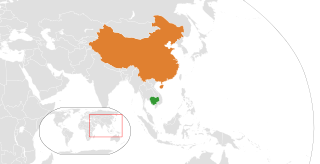
The bilateral relations between the Kingdom of Cambodia and the People's Republic of China have strengthened considerably after the end of the Cambodian–Vietnamese War, during which China had supported the Khmer Rouge against Vietnam.

Bilateral relations between the Republic of India and the Republic of Singapore have traditionally been strong and friendly, with the two nations enjoying extensive cultural and commercial relations. India and Singapore have signed the Comprehensive Economic Cooperation Agreement (CECA) and strategic-relationship agreement in order to increase trade, investments and economic cooperation, and expanded bilateral cooperation on maritime security, training forces, joint naval exercises, developing military technology and fighting terrorism.

China–Singapore relations, also known as Chinese–Singaporean relations or Sino–Singaporean relations, are the bilateral relations between the People's Republic of China and the Republic of Singapore. Singapore recognized the PRC in 1990. Diplomatic missions were established in the early 1990s based on trade and the warming of ties from other ASEAN countries towards mainland China.
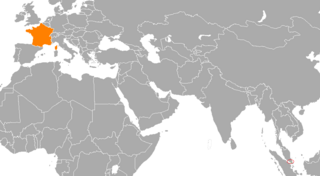
France–Singapore relations refers to the bilateral relations between the French Republic and the Republic of Singapore.

North Korea and the former country North Vietnam established formal diplomatic relations on January 31, 1950. In July 1957, North Vietnam President Ho Chi Minh visited North Korea; North Korean prime minister Kim Il Sung visited North Vietnam in November–December 1958 and November 1964. In February 1961, the two governments concluded an agreement on scientific and technical cooperation. North Vietnam merged with South Vietnam in 1976 to become the modern country of Vietnam.
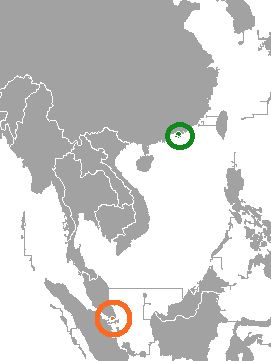
Both Hong Kong and the Republic of Singapore are former British colonies which have maintained trade relations since the 19th century, and have both become an important financial centre, maintaining diplomatic missions and trade offices to further their bilateral relations.

Bilateral relations between the Republic of Singapore and the Kingdom of Thailand formally date to 1965, when Thailand established diplomatic relations soon after the independence of Singapore. Both countries are the founding members of the Association of Southeast Asian Nations.

Relations between the Republic of Singapore and the Republic of Korea started when a trade mission from South Korea visited the Colony of Singapore in 1950. The two countries established formal diplomatic relations in 1975, but South Korea established a trade office and a consulate-general, and sent a special envoy to visit Singapore before that. Both countries are the only two United Nations members in the Four Asian Tigers. In 2014, South Korea was the fourth-largest import source of Singapore.

Myanmar–Singapore relations are bilateral relations between Myanmar and Singapore.



















